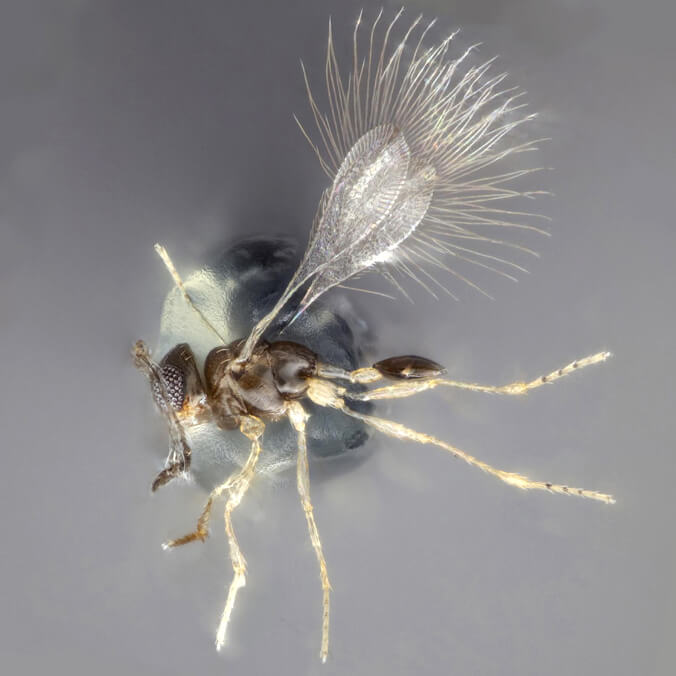
A new species of wasp was discovered on the University of Hawaiʻi at Mānoa campus. Mymarommatoidea—a group of miniscule but very beautiful wasps, around 0.5 mm in length—had been emerging from branches of a banyan tree on campus. Living individuals in their natural environment have never been recorded in scientific literature.
UH entomologists from the College of Tropical Agriculture and Human Resources named the new species Mymaromma menehune—“menehune” because like the menehune, they are small and elusive, rarely seen. The study was published in the Journal of Hymenoptera Research.

“It’s such a big world, so many little creatures living their lives doing all kinds of different things that us bigger, clumsier humans don’t often pick up on,” said David Honsberger, UH Mānoa graduate research assistant. “Here, a tiny beautiful wasp about the size of a grain of dust, finds the eggs of another tiny insect laid in the texture of bark, and parasitizes and develops in them.”
The previously undescribed species belongs to the last major group of parasitoid wasps about which nearly nothing regarding their biology was known. Entomologists have scant records of these wasps and no records of what they parasitize and how they develop. They are called parasitoid wasps because they insert their eggs within the eggs or bodies of host insects.
UH Mānoa researchers collected the banyan branches and scanned them under the microscope to locate any eggs laid on and under the bark. They then isolated the eggs in gel caps to see what would emerge. A few of the mymarommatids emerged. Researchers reared some of the same eggs and found they belonged to bark lice—the parasitoid-host association was confirmed. This species of mymarommatid parasitizes bark lice eggs. This is the first confirmation of the host species for any member of this group of wasps, a mystery since their first discovery 100 years ago.

The menehune wasps belong to a group that has a very unique body structure. The back of their head can expand like a bellows, their mandibles push outward instead of cut, they have beautiful fore wings with long setae (hair-like structures) around their edges, and hind wings consisting of just a stalk that forks at its end.
Because of their tiny size and short ovipositors, it was previously proposed that menehune wasps are likely parasitoids of arthropod eggs. Given their unique anatomy and patterns in collection records, it was suggested they might parasitize eggs of bark lice. This was suggested in part because the wasps may use their expandable head and reversed mandibles to break out through the flexible shell of bark lice eggs. They would then use their mandibles to open a tunnel to pass through the silk that some species of bark lice produce around their eggs. This recent discovery confirms these long-standing hypotheses.

The researchers involved in the discovery are Honsberger, Maya Honsberger and Mark Wright of UH Mānoa and John Huber of the Canadian National Collection of Insects. Also part of the team are Ali Miarkiani, Michelle Au, Shannon Wilson, Daniel Hausler, Vanessa Goodman and Laura Doucette of the Wright lab.
The discovery contributes to a deeper understanding of biodiversity. The more that is known about parasitoids, no matter how obscure, the more efficiently biological controls for invasive species can be developed in the future.
This effort is an example of UH Mānoa’s goal of Excellence in Research: Advancing the Research and Creative Work Enterprise (PDF), one of four goals identified in the 2015–25 Strategic Plan (PDF), updated in December 2020.

